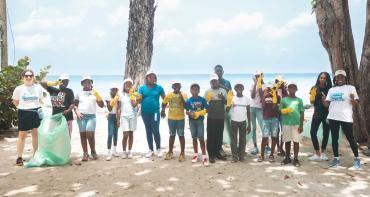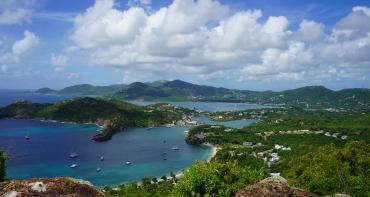The Commonwealth Blue Charter is sharing case studies to spotlight best practices and success stories from across the Commonwealth and beyond.

Share your own case study with us
“Communities met each other for the first time. This is positive; we want to create exchanges between them again. They really liked shaping the landscapes. Communities felt it was important to use more practical language when describing resilience and livelihood, like how do you survive or cope.”
Kathy Young, Managing Director of Reef Conservation
Summary
Improving the resilience of communities and coral reefs to changes anticipated as a result of climate change is an issue of global importance. Hundreds of millions of people rely on coral reefs to provide essential services such as food and coastal protection. Coral Communities aimed to examine the effectiveness of different management and development strategies, and to understand what language and messages would be most appropriate to facilitate and implement delivery of these. The project was carried out in two regions of the West Indian Ocean: Zanzibar and Mauritius.
This project has been included as a case study for the Blue Charter Action Groups as it showcases an in-depth process of engaging with coastal communities on complex topics, such as resilience, and the value of using creative methods to bring different communities and stakeholders together to discuss common challenges (illustrated by the quotation above).
The facilitation and engagement process provided through Coral Communities allowed in-depth discussion with community members, and highlighted the importance of understanding the values people hold about their local marine environment, and how this may influence future planning for resilience in these communities.
The issue
Coral Communities had two main aims:
- To identify and critically assess the effectiveness and potential of management and development strategies to build the resilience of coral reefs and their dependent communities in the Western Indian Ocean (WIO); and
- To understand to what extent ecosystem services language and approaches facilitate the development and implementation of such strategies.
In particular, the project sought to adopt creative and visual methods of community and stakeholder engagement to stimulate discussion on complex, and sometimes challenging, topics.
The response
The project engaged with WIO and UK stakeholders to discuss the concept of resilience and how different strategies could be used in practice to help build social and ecological resilience across the project region. Of particular interest to the Blue Charter Action Groups is the co-development of a novel and creative method that could be applied to engage local communities in challenging topics, such as ecosystem services, resilience, coral reef management and effective stakeholder engagement.
The project drew together a network of UK and WIO collaborators to address evidence and knowledge gaps around understanding of community knowledge, connection and values towards their local environment, with a specific focus on coral reefs and their resilience. It then used this to support the development of resilience strategies for coral reefs and their communities across the WIO.

Excerpt from Coral Communities newspaper, providing details about the methodology adopted, photographs from the project and reflections on the process.
To support meaningful engagement with local communities, the project team set out to develop a visually creative approach to exploring these complex issues. This involved a series of walking interviews, use of participatory videos and creation of “coastscapes” to stimulate discussion on topics relating to resilience and their local coral reefs. Crucially, the project sought to adopt a clear co-development process, moving away from a traditional researcher-led approach, with participants asked to interview each other about the objects they selected to include in creation of the coastscape. The approach was piloted in both Mauritius and Zanzibar, together with local non-governmental organisations (NGOs) Reef Conservation Mauritius and Mwambao Coastal Community Network.
In addition, two workshops were organised with secondary stakeholders (NGOs and government officials) to support understanding of key issues around coral reef resilience and strategic management, as well as to share the visual method with workshop participants. Workshop 1 involved the whole research team travelling to Mauritius and working with WIO and local stakeholders to start to understand the challenges facing coral reefs and to support development of the visual engagement tools, including the trial of a visual method of community engagement, participatory mapping and the creation of mini coastscapes (i.e. building a model of the coast in the workshop space and using it as a discussion tool to engage stakeholders and communities). Workshop 2 brought key people from across the WIO to the UK and built on the first workshop to feed back on the project and showcase the novel visual methods trialled with communities in Mauritius and Zanzibar.
Partnerships and support
The project team represented a range of interdisciplinary research and drew on expertise in environmental and health economics, social sciences, development, social psychology, marine geosciences, marine biology, art (including concept and sustainable design, and photography and film making) and religious studies.
The project was an international project funded by the Global Challenges Research Fund, enabling a partnership between academics, NGOs, a development consultant and a creative art and film-making team. It was led by Plymouth Marine Laboratory (PML), with partner organisations: University of Exeter (European Centre for Environment and Human Health and School of Geography), Reef Conservation, Tagscape, Truro College, Islamic Foundation for Ecology and Environmental Sciences, Mwambao Coastal Community Network, Indeva Consulting and Cardiff University. It brought together a wide range of expertise, including in the use of creative methods to engage communities, and supported the adoption of co-development of knowledge and engagement techniques.
Within the partnership, the Mwambao Coastal Community Network, a Tanzanian NGO, could be of particular interest to the Blue Charter Action Groups. This organisation has extensive expertise in using participatory video methods to engage communities in issues around marine and coastal management.²
Results, accomplishments and outcomes
In terms of overall outcomes, the process of stakeholder engagement was the main focus of the project. By involving different actors and community members in a co-developed, visually creative process, the project team was able to enhance engagement and awareness of issues relating to coral reefs, and their resilience, within the case study communities.

An example of a coastscape created through the Coral Communities project.
Results and outputs from the project include the following:
- A novel, arts-based approach was developed and piloted to assess perceptions of the environment and the socio-cultural risk associated with different resilience strategies. This process was used to encourage communities to express how they felt about their environment, how they interacted with it and what their aspirations were for the future. Coastscapes were created through a participatory visual process including walking interviews with participants and collecting of items to include.³ Participants co-created the coastscapes using items they had collected or brought with them to the meeting. This process of community engagement provided a platform for community voices and generated valuable insight into community perceptions and values about their local environment, and issues facing it. The project team is seeking on-going funding to further expand on this work.
- A “newspaper” was produced that summarises the aim of the project and provides a detailed overview of the process involved in the visual methods approach described above, including the development and use of the coastscapes as a discussion prompt. This project output was also co-designed with the community – a member of the community designed the logo and centre spread of the newspaper and their work set the colour scheme for the paper’s design.
- A pop-up project exhibition run in Mauritius showcased the coastscapes as well as photography and objects that project partners and stakeholders selected as representing the topics covered within the project, including the challenges and issues facing these communities around changing coral reef systems and what it meant to them individually and at a community level. The exhibition brought together a diverse range of stakeholders and community members and facilitated discussion on a range of topics.
- The project team conducted an in-depth literature review, focusing on 14 resilience strategies. This resulted in the creation of summary report cards, which can be freely downloaded from the project website in both English and French.
- The project team produced a number of videos, covering a range of topics including socio-ecological resilience and outlining the process of collecting objects from the coast to produce the coastscapes.
- A paper was produced on the resilience strategies applied in the WIO relevant to the development of social and ecological resilience (Hattam et al., 2020).
- A second paper is currently being developed focusing on the visual method and will be available from the project team (contact details below).
Challenges
Through the project, Coral Communities examined and addressed a number of challenges.
- Uncertainty and reluctance from project partners and WIO stakeholders around the creative methods being adopted through the project. This is a challenge that frequently faces social science approaches; however, through engaging project partners in the process, and the resulting depth of information and connection created through the methods used, many concerns expressed at the beginning of the project were addressed. WIO project partners have expressed how they have already used components of the methods, and there is considerable interest in adopting the methods for future projects.
- Understanding of key concepts and terms being used within the project, such as “ecosystem services”, “resilience” and “socio-ecological” systems, and how these are being adopted and used within the WIO region.
- Lack of monetary valuation processes in place to support understanding of cultural values and services that may be linked to coral reefs and their future resilience. This was found to be challenging for meaningful inclusion of cultural values within decision-making and management.
- Further challenges around literacy and language when working in different communities across WIO. However, the use of visual methods helped overcome many of these barriers.
- The short timeframe of the Coral Communities project, which meant stakeholders and communities were engaged frequently over a relatively short period of time, requiring a significant commitment from both the project team and the participants. Future projects would benefit from a longer timeframe, to reduce the risk of stakeholder fatigue, supported through regular communication to maintain engagement from participants.

Example of a “how to video” pocket book that you can photocopy back to back, fold up and share.
Key lessons learnt
Coral Communities emphasised the importance of meaningful and effective stakeholder engagement with local communities to support the development of sustainable marine and coastal management.
Use of visual methods
- To address the challenges of literacy and language within project communities, the Coral Communities project adopted a programme of visual and creative activities.
- It is important to recognise that care should be taken when using visual research methods, as imagery can mean one thing to one participant/community and something else to another.
- Visual and co-developed approaches providing an opportunity for open, transparent conversation and dialogue between different community members can build trust between different stakeholder groups, and can support public engagement with complex and challenging topics, such as resilience.
- Data and information collected through the visual activities can be digitised if time and funding allow, creating valuable resources that can be used to monitor changes in the environment, as well as in public perceptions and activities.
Time and resources
It is important to spend time with communities to develop a comprehensive understanding of different values and perceptions of their marine environments. For community engagement to be effective and meaningful, sufficient time and resources are required to support the use of creative methods, such as those developed by Coral Communities.
Reference
Hattam, C., Evans, L., Morrissey, K., Hooper, T. et al. (2020) “Building Resilience in Practice to Support Coral Communities in the Western Indian Ocean”. Environmental Science & Policy 106: 182–190.

Example of Coral Communities Report Cards (available in English and in French). Logo for the project created by Tooshir Beestobchurn from the Roches Noires community.
Additional resources
Coral Communities drew on experience from previous projects that may be of interest to the Blue Charter Action Groups interested in this type of creative or visual approach of engaging stakeholders/ communities. Information about one of these projects can be found below:
Tagscape explores ways of visualising information about natural landscapes and turning it into innovative maps that will engage the general public: https://www. plymouth.ac.uk/about-us/university-structure/faculties/ arts-humanities-business/creative-cultivator/tagscape
The process adopted through Coral Communities is also influencing new projects. One example of this is Ruritage – an EU-funded project seeking to examine rural cultural heritage and positioning it as a mechanism for supporting sustainable development and regeneration. More information is available on the project website: https://www.ruritage.eu/project/
Lead contact
Project Lead: Dr Caroline Hattam | E-Mail
For more information on creative methods: Dominica Williamson: https://www.ecogeographer.com
Website: https://www.pml.ac.uk/Research/Projects/Coral_Communities
Footnotes
1 https://pml.ac.uk/Research/Projects/Coral_Communities
3 https://pml.ac.uk/Research/Projects/Coral_Communities#videos
Download this case study (PDF)
View all Case Studies
Media contact
- Josephine Latu-Sanft Senior Communications Officer, Communications Division, Commonwealth Secretariat
- +44 20 7747 6476 | E-mail



